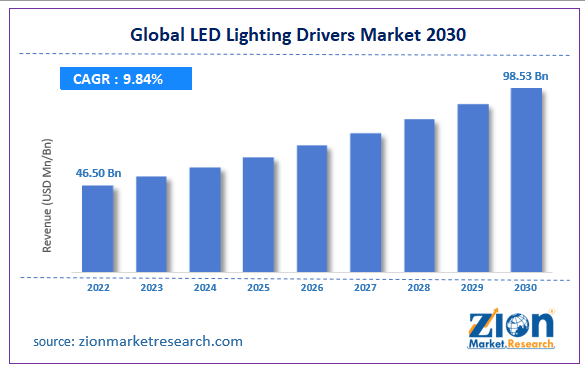Introduction:
The energy-efficient lighting sector has been revolutionized by the LED lighting drivers market, which is a crucial enabler in this field. We explore the expected market size, share, growth factors, trends, and projections for the LED Lighting Drivers business up until 2030 in this exhaustive analysis.
Market Size and Share:
With a projected CAGR (compound annual growth rate) of around 9.84% from 2023–2030, the global LED lighting drivers market is expected to expand from an estimated 46.50 billion USD in 2022 to 98.53 billion USD in 2030.

The global need for energy-efficient lighting solutions has been driving the expansion of the LED lighting drivers market. Essential to any LED lighting system, LED drivers improve the efficiency, lifespan, and controllability of the light bulbs. When more and more businesses, governments, and individuals switch to LED lights, the projected market size will skyrocket.
Several variables impact the market share of LED lighting drivers. These include smart lighting system adoption, advanced driver technology integration, government energy efficiency programs, and the overall growth of the LED lighting market. The market is ripe for the taking by businesses that provide LED drivers that are dependable, programmable, and energy efficient.
The global LED lighting drivers market is led by players like:
- Mean Well
- Philips Lighting (Signify)
- Tridonic
- Osram GmbH
- Thomas Research Products
- EldoLED
- ERP Power
- Inventron Electronics
- Inventronics
- Advance Transformer Co.
- Delta Electronics
- MOSO Power Supply Technology
- MEAN WELL USA
- ON Semiconductor
- LIFUD
Market Trends:
- Smart Lighting Integration: The trend involves the integration of LED drivers into smart lighting systems. Smart lighting, enabled by advanced drivers, allows for remote control, color customization, and automation, contributing to energy savings and enhanced user experiences.
- Human-Centric Lighting: The trend includes the implementation of human-centric lighting solutions driven by LED drivers. Dynamic lighting systems that mimic natural daylight cycles and support circadian rhythms are gaining popularity in residential, commercial, and healthcare settings.
- Wireless Connectivity: The trend involves the adoption of wireless connectivity in LED lighting systems. LED drivers with wireless communication capabilities enable seamless integration into smart home and building automation systems.
- Focus on Energy Efficiency: The trend encompasses a continued focus on energy efficiency in LED lighting systems. LED drivers with high power factor correction, dimming capabilities, and optimization for energy savings align with global sustainability goals.
Growth Factors:
- Government Initiatives for Energy Efficiency: The growth of the LED Lighting Drivers market is driven by government initiatives promoting energy-efficient lighting. Incentives, regulations, and standards encouraging the adoption of LED technology contribute to market expansion.
- Rapid Expansion of LED Lighting Infrastructure: The growth is influenced by the rapid expansion of LED lighting infrastructure in various applications. From street lighting to residential and commercial spaces, the increasing deployment of LED lighting systems drives demand for LED drivers.
- Technological Advancements in LED Drivers: Ongoing technological advancements, including improvements in driver efficiency, reliability, and compatibility with emerging LED technologies, are significant growth factors. LED drivers that support innovations such as tunable white light and color-changing capabilities contribute to market growth.
- Demand for Smart Home Solutions: The growth of the market is connected to the increasing demand for smart home solutions. LED drivers that enable connectivity with home automation systems, voice-controlled assistants, and mobile applications cater to the growing trend of smart home integration.
Forecast for 2030:
The LED Lighting Drivers market is poised for continued growth, driven by the global push towards energy efficiency, the evolution of smart lighting systems, and ongoing innovations in LED technology. Projections indicate an expanding market size as LED lighting becomes the dominant lighting solution across various sectors.
Conclusion:
As the LED Lighting Drivers market evolves, manufacturers, lighting designers, and sustainability advocates must collaborate to address challenges, enhance compatibility, and ensure the seamless integration of LED lighting solutions into diverse applications. The future of the LED Lighting Drivers market is not just about illumination; it’s about paving the way for a more efficient, adaptable, and sustainable approach to lighting in the digital age.


